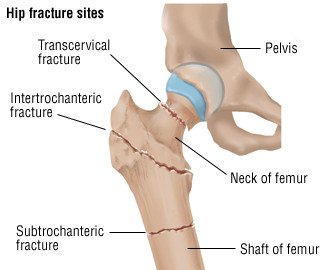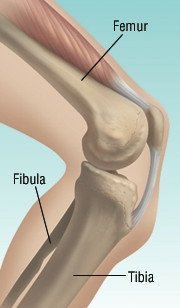Leg Fracture
Medically reviewed by Drugs.com. Last updated on Jan 22, 2024.
What is a Leg Fracture?

Whenever a bone breaks or cracks, the injury is called a fracture. The leg has three bones that can fracture — the femur (the thighbone) and the tibia and fibula in the lower leg. When a fracture involves the knobby end portions of bones that are part of the hip, knee and ankle joints, the fracture is more complicated. This article describes only fractures of the straight shafts of the three long leg bones.
Femur Fractures
The femur is very strong, so it takes a lot of force to fracture this bone in healthy people. The femur usually fractures during high-impact trauma, especially in automobile accidents, industrial accidents, falls from high places or gunshot wounds to the thigh. If a low-impact bump or fall causes a femur to fracture, this may be a sign that the femur has been weakened by an illness, such as osteoporosis or cancer.
|
|
Femur fractures have the potential to cause dangerous, sometimes life-threatening complications, such as significant bleeding inside the thigh, with blood loss of one quart or more. A femur fracture also may cause blood clots to form within the large veins of the thigh. If these clots break free and travel through the bloodstream, they may eventually lodge in the lungs, creating a life-threatening condition called a pulmonary embolism.
Among children, femur fractures tend to happen because of a fall from a high place, such as a tree or the top of a slide. In adults, these injuries usually are related to motor vehicle accidents (either as a passenger or pedestrian) or to on-the-job trauma. The number of femur fractures caused by gunshot wounds has risen significantly in recent years.
Tibia Fractures
The tibia (shinbone) is the larger of the two bones of the lower leg. Like femur fractures, tibia fractures often occur because of direct, high-impact trauma, especially during motor vehicle accidents. However, the tibia also can fracture from a low impact, even in healthy people, if the lower leg is bent or twisted at just the right angle.
|
|
Of all the body's long bones, the tibia is the most likely to be fractured and the most likely to break through the skin when it fractures. This greatly increases the risk of bacterial contamination and infection at the fracture site. It also may prevent normal healing. The sharp ends of a broken tibia can cut into nearby nerves and blood vessels and cause serious damage to soft tissues inside the lower leg.
In 75% to 85% of patients with tibia fractures, the fibula (the thin bone at the outer side of the lower leg) is fractured as well.
Fibula Fractures
The fibula runs parallel to the tibia on the outside of the lower leg, but is smaller. The fibula usually fractures at the same time as the tibia. When only the fibula fractures, it is usually because of a direct blow to the side of the leg or an extreme sideways bend at the ankle or knee.
When only a fibula fractures, it usually does not cause long-term complications. Rarely, when the segments of broken bone are separated significantly by the injury, one of the nerves to the foot may be injured, causing foot drop, a condition in which the foot hangs limp at the ankle and drags on the ground during walking.
Symptoms
If you have fractured the shaft of your femur, your symptoms may include:
- Pain, swelling, tenderness and bruising in your thigh
- Inability to bear weight on your injured leg
- Inability to move your hip or knee on the affected side
- Visible portions of the fractured bone, if the fracture causes a break in the skin
If you have fractured the shaft of your tibia, or both your tibia and fibula, you may see:
- Pain, swelling, tenderness and bruising in your lower leg
- Deformity in the shape of your lower leg
- An abnormal alignment or positioning of your foot on the affected side
- Visible portions of the fractured bone, if the fracture causes a break in the skin
A fibula fracture that occurs alone usually causes:
- Localized swelling and tenderness at the fracture site, along the outside of the lower leg
- Pain at the outside of the lower leg that becomes worse when you walk
Diagnosis
Your doctor will examine your injured leg, checking for swelling, deformity, abrasions, bruising and tenderness. To help determine whether a sharp edge of broken bone has damaged your leg's blood vessels or nerves, the doctor also will feel the pulses along the length of your injured leg, will assess how you respond to touch and will check for normal muscle strength in your leg and foot. If the physical examination suggests that your leg's arteries or large veins may have been injured, the doctor will order specialized tests called Doppler studies to measure the leg's blood flow more precisely.
Your leg will be X-rayed to confirm the location and severity of your fracture, and to check for less-obvious fractures and dislocations in nearby joints.
Expected Duration
A leg fracture may take two or more months to heal depending on whether surgery is necessary; whether there were multiple fragments; and whether there were complications, such as infection.
Prevention
The best way to avoid fractures is to prevent accidents. Supervise children and encourage safe play. Drive carefully and always wear a seat belt. For information about how to prevent work-related injuries in construction and other occupations, visit the website of the National Institute for Occupational Safety and Health (NIOSH). Prevention of osteoporosis can reduce the risk of related fractures.
Treatment
Femur Fractures
In most cases, doctors prefer to repair the fracture surgically. Surgical repair usually requires a shorter hospital stay and creates less disability than other treatment methods, such as wearing a plaster cast that covers the entire leg and hip.
To repair your fracture, the surgeon will join the segments of your broken femur using a special metal rod that is inserted into the bone's inner cavity. This rod will stabilize and reinforce the fracture site, allowing the femur to heal quickly and firmly. Once healing is complete, the metal rod may be removed or left in place.
|
|
After surgery, you will need to use crutches to avoid bearing weight on the leg, followed by a program of physical therapy. The goal of physical therapy is to restore normal strength in your leg muscles and normal range of motion in your leg joints. The entire process of healing and rehabilitation usually takes months.
Tibia Fractures
Treatment depends on the severity and location of your tibia fracture. If you have an uncomplicated fracture that is not near your knee or ankle, the doctor may be able to treat your injury by immobilizing your leg in a cast. More severe fractures usually have to be repaired surgically with a metal rod, wires, or plates and screws.
Fibula Fractures
In general, a fibula fracture that occurs without a tibia fracture can be treated without surgery or hospitalization. Your doctor probably will tell you to rest the injured leg, apply ice to the injured area, and take a nonsteroidal anti-inflammatory drug (NSAID), such as ibuprofen (Advil, Motrin and others), to ease pain and relieve swelling. If bearing weight on your injured leg is very painful or if the fracture is near the ankle, your doctor may apply a cast and recommend that you use crutches temporarily.
For any of these fractures, if your fracture breaks the skin, the condition is more serious: debridement (removal of foreign material or damaged tissue from the wound), surgery and intravenous antibiotics are usually recommended. If you have not had a tetanus shot within the past 10 years, a tetanus vaccination will also be recommended.
Once your fracture has healed enough, your doctor will prescribe a program of physical therapy to restore full strength and function in your injured leg.
When To Call a Professional
Seek emergency help if you have significant lasting pain and suspect you may have a leg fracture after a fall, a motor vehicle accident or other trauma involving the leg.
Prognosis
The outlook for leg fractures varies, depending on the type of fracture and its severity:
- Femur fractures — Almost all femur fractures heal well, and most patients are able to return to their normal activities after about 6 months of treatment and rehabilitation. Among elderly patients with weakened bones, the rate of repeat fractures is high, ranging from 1% to 15%.
- Tibia fractures — Tibia shaft fractures also have a good prognosis. Fractures that are closer to the knee tend to heal faster than those near the ankle. Fractures in children tend to heal faster than those in adults.
- Fibula fractures — Almost all fractures of the fibula shaft heal very well without complications.
Additional Info
National Institute of Arthritis and Musculoskeletal and Skin Diseases
http://www.niams.nih.gov/
National Rehabilitation Information Center (NARIC)
http://www.naric.com/naric/
National Institute for Occupational Safety and Health
http://www.cdc.gov/niosh/
Further information
Always consult your healthcare provider to ensure the information displayed on this page applies to your personal circumstances.



